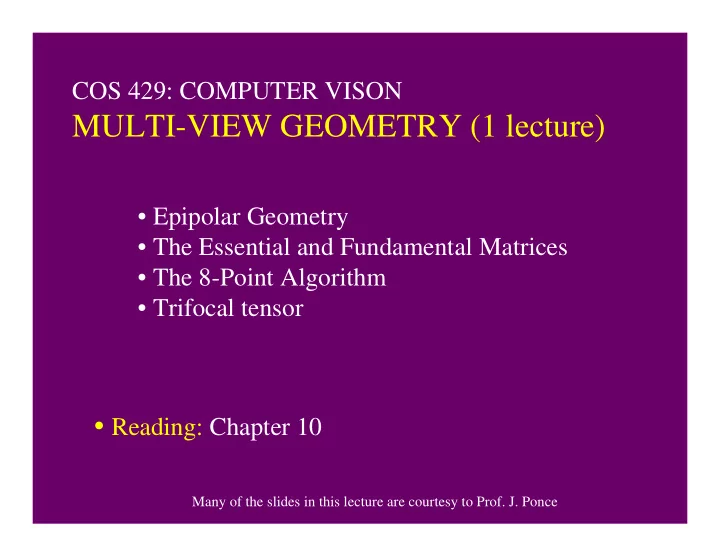

COS 429: COMPUTER VISON MULTI-VIEW GEOMETRY (1 lecture) • Epipolar Geometry • The Essential and Fundamental Matrices • The 8-Point Algorithm • Trifocal tensor • Reading: Chapter 10 Many of the slides in this lecture are courtesy to Prof. J. Ponce
Reconstruction / Triangulation
(Binocular) Fusion
Epipolar Geometry • Epipolar Plane • Baseline • Epipoles • Epipolar Lines
Epipolar Constraint • Potential matches for p have to lie on the corresponding epipolar line l’ . • Potential matches for p’ have to lie on the corresponding epipolar line l .
Epipolar Constraint: Calibrated Case Essential Matrix (Longuet-Higgins, 1981)
Properties of the Essential Matrix • E p’ is the epipolar line associated with p’. • E p is the epipolar line associated with p. T • E e’=0 and E e=0. T • E is singular. • E has two equal non-zero singular values (Huang and Faugeras, 1989).
Epipolar Constraint: Small Motions To First-Order: Pure translation: Focus of Expansion
Epipolar Constraint: Uncalibrated Case Fundamental Matrix (Faugeras and Luong, 1992)
Properties of the Fundamental Matrix • F p’ is the epipolar line associated with p’. • F p is the epipolar line associated with p. T • F e’=0 and F e=0. T • F is singular.
The Eight-Point Algorithm (Longuet-Higgins, 1981) Minimize: under the constraint | F | =1. 2
Non-Linear Least-Squares Approach (Luong et al., 1993) Minimize with respect to the coefficients of F , using an appropriate rank-2 parameterization.
The Normalized Eight-Point Algorithm (Hartley, 1995) • Center the image data at the origin, and scale it so the mean squared distance between the origin and the data points is 2 pixels: q = T p , q’ = T’ p’ . i i i i • Use the eight-point algorithm to compute F from the points q and q’ . i i • Enforce the rank-2 constraint. • Output T F T’ . T
Data courtesy of R. Mohr and B. Boufama.
Without normalization Mean errors: 10.0pixel 9.1pixel Mean errors: With normalization 1.0pixel 0.9pixel
Trinocular Epipolar Constraints
Trinocular Epipolar Constraints These constraints are not independent!
Trinocular Epipolar Constraints: Transfer Given p and p , p can be computed 1 2 3 as the solution of linear equations.
Trifocal Constraints
Trifocal Constraints Calibrated Case All 3x3 minors must be zero! Trifocal Tensor
Trifocal Constraints Uncalibrated Case Trifocal Tensor
Properties of the Trifocal Tensor T i • For any matching epipolar lines, l G l = 0. 2 1 3 • The matrices G are singular. i 1 • They satisfy 8 independent constraints in the uncalibrated case (Faugeras and Mourrain, 1995). Estimating the Trifocal Tensor • Ignore the non-linear constraints and use linear least-squares a posteriori. • Impose the constraints a posteriori.
T i For any matching epipolar lines, l G l = 0. 2 1 3 The backprojections of the two lines do not define a line!
Multiple Views (Faugeras and Mourrain, 1995)
Epipolar Constraint Two Views
Trifocal Constraint Three Views
Quadrifocal Constraint (Triggs, 1995) Four Views
Geometrically, the four rays must intersect in P ..
Quadrifocal Tensor and Lines
Scale-Restraint Condition from Photogrammetry
Recommend
More recommend